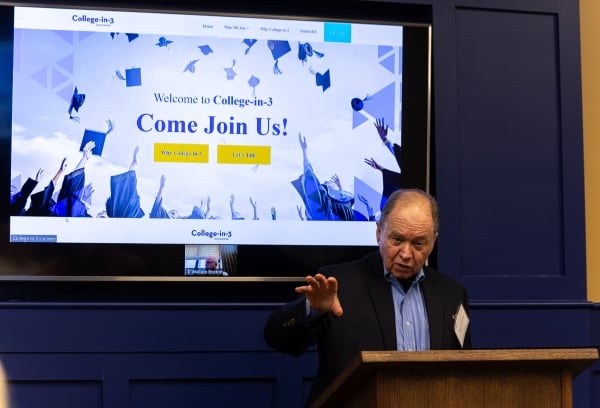You have /5 articles left.
Sign up for a free account or log in.

The College-in-3 Exchange hopes to have 100 member colleges by the end of the year, according to Executive Director Madeleine Green.
Photo illustration by Justin Morrison/Inside Higher Ed | Getty Images | Rawpixel
Last month, Manchester University, a private liberal arts college two hours north of Indianapolis, became the first college in Indiana to win approval to offer reduced-credit bachelor’s degrees.
The college has long offered students the chance to graduate early by taking more courses each semester, an option called Fast Forward. But it wasn’t until recently that its accrediting body, the Higher Learning Commission, began allowing institutions to develop three-year bachelor’s programs, which require students to earn about 90 credits rather than the usual 120. (In most cases, electives are eliminated.) As soon as HLC granted permission, Manchester president Stacy Young said, the university started looking into which programs it might be able to offer on a reduced-credit basis.
“The opportunity to do the reduced credit really kind of opened up our eyes to say, what could this mean to our students?” Young said. The university eventually received approval for three-year options in two of their most popular programs: pre–athletic training and pre–physical therapy. Officials now plan to submit six more proposals in the near future.
The first three-year degree programs in the country—online programs at Brigham Young University–Idaho and Ensign College in Utah—gained approval just two years ago. Since then, the number of shortened degree programs has expanded exponentially, with nearly 60 colleges nationwide now offering or working toward developing such programs.
The movement has come a long way since April 2024, when the College-in-3 Exchange, a new organization dedicated to promoting interest in the three-year degree, held a meeting in Massachusetts to discuss its progress. Though advocates celebrated the success of the truncated degree programs granted to BYU-Idaho and Ensign in summer 2023, no in-person three-year programs had yet been approved, and most accreditors still seemed skeptical of the concept.

Robert Zemsky at the College-in-3 convening in April 2024.
Merrimack College
Since then, every accreditor in the U.S. has done an about-face, implementing or clarifying their policies to allow colleges to propose degrees with fewer than 120 credits. Many accreditors have already approved programs, including the country’s first in-person reduced-credit degrees: computer science, criminal justice, graphic design and hospitality management at Johnson & Wales University, which were approved by the New England Commission of Higher Education and will launch this fall. Some state higher education leaders are enthusiastically backing the movement, in some cases adjusting regulations or releasing guidance to make it easier to create these programs.
“We are wildly successful for a new movement,” said Robert Zemsky, a University of Pennsylvania professor who has been championing the concept of three-year degrees for over 15 years. “We are changing higher ed, and that’s a very unusual exercise.”
It’s not hard to see why the three-year degree is experiencing a surge in popularity. At a time when politicians and families alike are bemoaning what they perceive as the exorbitant cost of higher education, three-year degrees seem like a perfect balm, allowing students to graduate and join the workforce sooner for a lower price tag.
The increase in three-year programs also comes at a time when President Donald Trump is increasingly railing against traditional higher education in favor of workforce readiness initiatives—though Zemsky and other college-in-three advocates argue that the shortened degree movement need not replace or come at the expense of a regular college education.
Still, concerns continue to swirl around three-year degrees—and influence what the programs look like in practice. Critics question, for example, whether the programs will produce the same learning outcomes as traditional bachelor’s degrees, leading most accreditors and institutions launching accelerated programs to describe them as pilots, whose efficacy they will evaluate in four or five years. And even as more institutions embrace the idea of the three-year degree, many are reluctant to dive in, opting instead to develop just a few shortened degree programs for starters.
Nevertheless, the progress is encouraging, said Madeleine Green, the executive director of the College-in-3 Exchange, especially now that accreditors—historically the biggest obstacle to such programs—have come around.
“I think that’s really lightning speed and a very positive sign,” said Green, who noted that the group hopes to grow from 59 members to 100 by Christmas. “As with any new movement or concept, things take a while to take root. People have to know about it. Institutions are temperamentally cautious—that they’re trying an experiment with one or two programs is not surprising … I think we’re en route and the territory is shifting.”
Accreditors on Board
For years, accreditors resisted approving shortened degree programs, fearful that cutting credit hours from degrees would result in subpar versions of those programs. Many also had enshrined in their standards that a bachelor’s degree must have a minimum of 120 credits.
For decades and decades and decades, people have known what an associate degree is, and historically it has been 60 credits and the baccalaureate is 120 credits … [We’re] trying to sort of figure out what exactly this degree is.”
—Larry Schall, president of the New England Commission of Higher Education
But when the Northwest Commission on Colleges and Universities approved the first three-year programs at BYU-Idaho and Ensign in 2023, the commission’s then-president, Sonny Ramaswamy, told Inside Higher Ed that his research into the arbitrary origins of the 120-credit-hour bachelor’s degree had convinced him that a reduced-credit program wouldn’t inherently be inferior to its four-year counterpart. (Indeed, Tim Knowles, the president of the Carnegie Foundation, which originated the concept of the credit hour, has expressed support for three-year degrees.) Ramaswamy also noted that bachelor’s degrees in many other countries, including the United Kingdom, are only three years.
Other accreditors have followed suit. The Higher Learning Commission, the country’s largest accreditation body, finalized a process for evaluating three-year program proposals in September and has since approved eight programs, including the two at Manchester.
NECHE declined a proposal for a 100-credit program in spring 2023, saying that “graduates of 100-credit baccalaureate programs would not receive equivalent benefit.” But it, too, reversed course, publishing its own guidelines for three-year degrees in March 2024 before approving the Johnson & Wales plan in September.
Many of the accreditors’ policies include requirements for naming the programs; most prohibit the use of the term “bachelor’s” for three-year degrees to avoid confusion with traditional 120-credit programs. Some colleges have used terms like an “accelerated” or “applied” bachelor’s degree; the Southern Association of Colleges and Schools Commission on Colleges, which published its three-year degree guidance this past March, recommends the titles “undergraduate specialist” or “workforce specialist” degrees. The guidelines also typically require colleges to be transparent about the fact that graduate schools and employers may not accept a 90-credit degree in place of a four-year bachelor’s.
The requirements aim to address the general public’s lack of knowledge about what a three-year degree entails and what it can be used for.
“For decades and decades and decades, people have known what an associate degree is, and historically it has been 60 credits and the baccalaureate is 120 credits, and people know what a master’s degree is and people know what a Ph.D. is,” said Larry Schall, president of NECHE. “[We’re] trying to sort of figure out what exactly this degree is, because we have decided that it is worthy of being a baccalaureate,” even though it conflicts with the standards that define a bachelor’s degree as being 120 credits.
He said NECHE plans to complete a multiyear assessment of the learning outcomes of the three-year degrees it has approved to evaluate whether they are on par with a four-year bachelor’s.
State Support—and Setbacks
States and public higher education systems are also encouraging their colleges and universities to launch three-year programs. The University of Maine system recently approved five online reduced-credit programs across four of its campuses, which await approval from NECHE. Indiana passed a law in 2024 requiring public bachelor’s-granting institutions to develop at least one three-year program by this month. And last year, the Utah System of Higher Education encouraged public colleges to develop such programs, creating a new degree category—bachelor’s of applied studies—for degrees of between 90 and 120 credit hours.
These steps seem to have borne fruit; last week, USHE announced that it had approved the state’s first reduced-credit programs at two Utah universities. The programs await accreditation.
“These new pathways are about student success,” said Brad Mortensen, president of Weber State University, which has proposed two reduced-credit degrees: sound production/recording and an interdisciplinary degree in politics, philosophy and economics, in the announcement. “Providing accelerated pathways in select programs saves time and money while achieving the same learning outcomes. We want to meet students where they are and help them reach their goals more efficiently, without sacrificing the value of their education. These programs are another tool to help more Utahns graduate and thrive in our state.”
But for other institutions, state regulations remain a barrier. Several state higher education commissions include a 120-credit-hour minimum for bachelor’s degrees in their regulations, preventing them from approving truncated degrees without altering their policies.
We care about responsible innovations—that includes careful measurement of impact in order to determine whether the innovation is actually helpful, but we are pro-innovation.”
—Chris Gabrieli, Massachusetts Board of Higher Education chair
For instance, in Massachusetts, NECHE has approved a three-year program at Merrimack College, but state regulations have prevented the plan from moving forward. (Merrimack did not respond to a request for comment.)
The Massachusetts BHE is currently in the process of developing new guidelines that would allow colleges to submit for approval pilot programs that don’t align with existing regulations and standards, known as an “innovation pilot.” That would include bachelor’s degrees that are under 120 credits.
“Our board has been focusing on these issues because we are affirmatively pro-innovation in higher ed,” Chris Gabrieli, the chair of Massachusetts’s BHE, told Inside Higher Ed in an interview. “We care about responsible innovations—that includes careful measurement of impact in order to determine whether the innovation is actually helpful, but we are pro-innovation. Having new regulation that would align us with the accreditor for our region to allow colleges, public and private, to apply with ideas of innovations that are not yet allowed by our rules but appear worthy and where they’re willing to provide the data on the outcomes seems like, potentially, a strong pro-innovation policy.”
In addition to whether three-year programs will offer a complete liberal arts education, stakeholders are mainly concerned about employment outcomes for three-year bachelor’s graduates and whether they will be able to get into graduate school, Gabrieli said.
He acknowledged that it’s hard to know whether employers will be accepting of three-year degrees—and that it would be a major problem if students thought they were getting what is essentially a bachelor’s degree, only to find out after graduation that that isn’t the case. Employers may, indeed, treat reduced-credit degrees the same as a regular bachelor’s, but that’s something colleges won’t know for sure until after their first class of three-year degree students are entering the workforce.
He also noted that colleges should only launch programs if they feel they will genuinely benefit their students—not as a last-ditch effort to boost enrollment.
The Massachusetts board is slated to vote to finalize the regulations and begin accepting public comment in late summer or early fall.
The Landscape Now
As three-year programs crop up across the country, the image of what these degrees will look like in practice is starting to take shape. The large majority of them focus on certain professional fields, including criminal justice, cybersecurity or pre–physical therapy; almost none are degrees in the humanities or hard sciences.
“They’ve sort of been things that lead you straight to a first job, and areas where employers are struggling to get people,” said Schall, the NECHE president.
That doesn’t necessarily mean those are the only types of programs that suit the three-year model, Zemsky argued. But faculty in “traditional” majors, like the humanities, are especially resistant to taking on the challenge of offering a shortened degree, he said.
“The bad news is, I think in the traditional disciplines, there isn’t as much movement,” he said. “I wish some history department would take it on. We don’t have a history department yet that’s said, ‘We’re going to do a history degree in three years,’ and in some ways, it makes our life harder because it looks like we aren’t interested in traditional higher education, and we are. But we can’t lead people to water.”
Many of the proposed programs also focus on adult learners; the five programs in the University of Maine system, for example, are targeted solely at individuals who have completed some college but have been out of higher education for at least two years. Raymond Rice, the president of the University of Maine at Presque Isle, which is offering two programs as part of its existing competency-based education program, said that three-year degrees are a perfect solution for adult learners who “just need the diploma.”
To some, targeting adult learners also justifies, in part, the reduced-credit format; many of them have work experience that can stand in for electives not included in the reduced-credit program.
“For a single mom to go back to school, this might be the way that they do that a little bit faster. Having those 30 elective credits that we have, for the most part, eliminated in this program—those might be luxury classes and they really just need their piece of paper,” said Young, the Manchester University president.
Still, Rice said he wouldn’t discount the idea that someday, traditional-aged students could enroll in UMPI’s three-year degrees.
“Evidence shows that increasingly learners of all ages … [are] looking for different ways of learning and different modalities,” he said. “I think the lessons we learn will be applicable in other demographics of students because I just think that’s where higher education is heading.”




